
| Version | Summary | Created by | Modification | Content Size | Created at | Operation |
|---|---|---|---|---|---|---|
| 1 | Vivi Li | -- | 7306 | 2022-11-15 01:40:14 |
Video Upload Options
The straight-six engine (also referred to as an inline-six engine; abbreviated I6 or L6) is an internal combustion engine, with six cylinders mounted in a straight line along the crankcase with all the pistons driving a common crankshaft (straight engine). The bank of cylinders may be oriented at any angle, and where the bank is inclined away from the vertical, the engine is sometimes called a slant-six (although this is also a Chrysler-specific design). The straight-six layout is the simplest engine layout that possesses both primary and secondary mechanical engine balance, resulting in much less vibration than engines with fewer cylinders.
1. Displacement Range
In automobiles, the straight-six design is used for engine displacements ranging from approximately 2 to 5 litres (120 to 310 cu in).[1] It is also sometimes used for smaller engines but these, although very smooth running, tend to be rather expensive to manufacture in terms of cost-to-power ratio. Since the length of an engine is roughly proportional to the number of cylinders in one bank, the straight-six is necessarily longer than alternative layouts such as I4, V4, V6, or V8.
One of the smallest production straight-sixes was found in the Benelli 750 Sei motorcycle, displacing 747.7 cc (45.63 cu in) (0.7477 L).[2] Honda and Mike Hailwood raced in the 1960s with the RC166 250 cc (15 cu in) (0.25 L) six-cylinder, 24-valve motorcycle engine. Pre-World War II engines could be quite large by modern standards — such as the Rolls Royce Silver Ghost's 7.4 L engine and the 824 cu in (13.5 L) of the 1910s Peerless, Pierce, and Fageol.
The largest modern passenger-car straight-sixes include the 4.6 L (282 cu in) VAM version of AMC's engines, the 4.2 litre powerplants found in several Jaguars and AMCs, 4.0 TVR Speed Six, 4.0 Ford Barra, Chevrolet 250, Chevrolet Vortec 4200, 4.3 Chrysler Hemi Six, 4.2 Toyota Land Cruiser (both diesel and petrol), 4.5, and 4.8 Nissan, 4.8 Chevrolet, 4.9 Ford, and the 5.0 L of Hudson H-145 (produced until 1957). As of 2009, the Cummins B Series engine used in Dodge Ram pickup trucks displaced up to 6.7 L[3]
The Gipsy Six and Gipsy Queen, made by the de Havilland Engine Company from 1935 until 1950, were inverted straight-six engines displacing 560.6 cubic inches (9.187 L). They were used in a variety of aircraft including the de Havilland Dragon Rapide and the Cierva W.9 experimental helicopter. The standard straight-six configuration World War I aviation engines used by the German Empire's Luftstreitkräfte aircraft possessed even larger displacements, with the most-used Mercedes D.III family of liquid-cooled, dual ignition, SOHC-valvetrain inline-six engines having a massive 14.8 litres (903 cu in).
Because it is a fully balanced configuration, the straight-six can be scaled up to very large sizes for heavy truck, industrial and marine use, such as the 16 L (980 cu in) Volvo diesel engine and the 15 L Cummins ISX used in heavy vehicles.[4] The largest are used to power ships, and use fuel oil. The straight-six can also be viewed as a scalable modular component of larger motors which stack several straight-sixes together, e.g. flat- or V-12s, W-18s, etc.
2. Cars
Straight-six engines were introduced much earlier than V6 engines. While the first straight-six was manufactured in 1903 by Spyker, it was not until 1950 that a production V6 was introduced. V6s (unlike crossplane V8 engines) had intrinsic vibration problems not present in the straight-six.
The length of the straight-six was not a major concern in the older front-engine/rear-wheel drive vehicles, but the modern move to the more space-efficient front-engine/front-wheel drive and transverse engine (left-to-right versus front-to-back) in smaller cars made the length of the V6 a major advantage. The overall length of an engine may be approximated by adding the bore pitch times the number of cylinders in one bank, plus the width of one connecting rod. As a result, in recent decades automobile manufacturers have replaced most of their straight-six engines (and many of their V8s) with V6 engines; Nissan have replaced their earlier turbocharged inline-6 models with larger displacement naturally aspirated V6 engines while maintaining the FR setup.
Exceptions to the shift to V engines include BMW, which specializes in high-performance straight-sixes used in a lineup of front-engine/rear-wheel-drive vehicles, all of BMW's current 6-cylinder model line-up use the straight configuration, Volvo, which designed a compact straight-six engine/transmission package to fit transversely in its larger cars, and the Australian Ford Falcon, which still uses a straight-six configuration. TVR used a straight-six configuration exclusively in their final cars before their demise.
Manufacturers began to replace V8 engines with straight-6 engines and V6 engines with straight-4 engines, while V8 engines became smaller. This was a part of a trend toward higher efficiency engines with fewer cylinders, but the same power output as previous larger engines as fuel economy standards became more stringent. A result of modular engine designs was that straight-6 engines could be built on the same assembly lines as straight-4 engines, while V8 engines smaller than previous V8s could be built with the same components as straight-4 engines in the same family.[5] In a reversal of previous trends, Mercedes-Benz announced a return to inline-6 engines in October 2016.[6]
Increasingly straight-six engines are also being replaced by turbocharged in-line four cylinder engines that offer comparable top-end power output and reduced low-end torque but with better fuel efficiency, due to smaller displacements and lower friction from the reduced number of cylinders. The poor secondary harmonic balance of straight four-cylinder engines is sometimes addressed with the use of balance shafts, but they are not inherently as smooth as an inline-6.
2.1. Trucks
Straight-sixes continue to be used in medium to large trucks. Ford is one notable exception using a V8 in medium duty trucks. GM pickup trucks abandoned the straight-six in 1984 for the 4.3 V6, Ford dropped the straight-six in favour of the Essex V6 in 1996. In 2002, General Motors introduced the Vortec 4200 as part of the modular straight-four, straight-five and straight-six GM Atlas engine line. It was used in their small sport utility vehicles. Jeep abandoned the straight-six in 2006 with the 2006 Jeep Wrangler being the last vehicle. Ram Trucks continues to offer straight-six engines in its heavy duty pickup truck and chassis cab models, although only V6 and V8 engines are available in the smaller versions. Although it has lower horsepower than the alternative V8 Chrysler Hemi engine, the higher torque and better fuel economy of the Cummins 6.7 litre turbocharged diesel straight six engine makes it more suitable for towing heavy loads for long distances. The 6.7 L Cummins turbo-diesel is currently the largest straight-six engine offered in a pickup truck.[7]
3. Balance and Smoothness
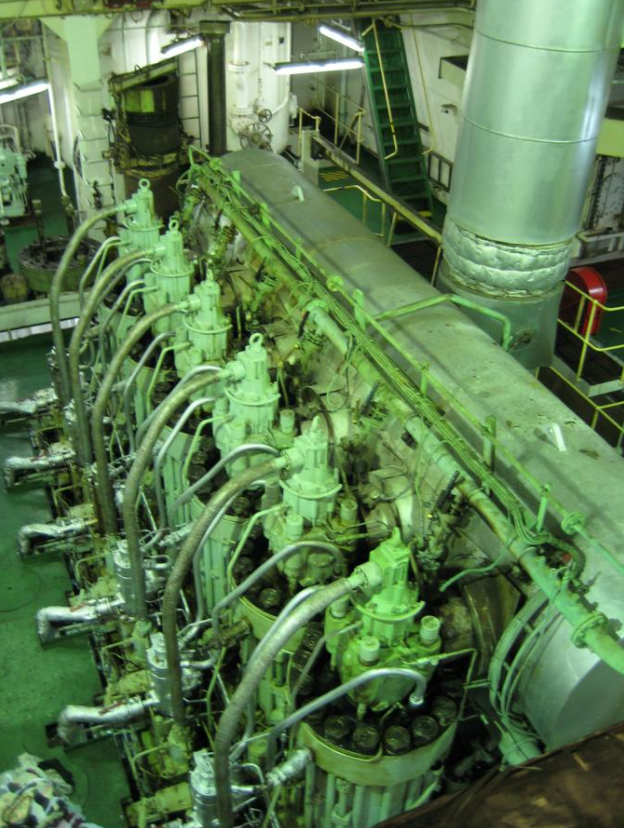
An inline six engine is in practically perfect primary and secondary mechanical balance, without the use of a balance shaft. The engine is in primary couple balance because the front and rear trio of cylinders are mirror images, and the pistons move in pairs (but of course, 360° out of phase and on different strokes of the 4-stroke cycle). That is, piston #1 mirrors #6, #2 mirrors #5, and #3 mirrors #4, largely eliminating the polar rocking motion that would otherwise result.
Secondary imbalance is largely avoided because the crankshaft has six crank throws arranged in three planes offset at 120°. The result is that the bulk of the secondary forces that are caused by the pistons' deviation from purely sinusoidal motion sum to zero. Specifically, the second-order (twice crank speed) and fourth-order inertial free forces (see engine balance article) sum to zero, but the sixth-order and up are non-zero. This is typically a tiny contribution in most applications, but may be significant with very large displacements, despite the usual and advantageous use of long connecting rods reducing the secondary (second-order and up) oscillation in the piston motion in those applications.
An inline four cylinder, or even a V6 engine with a crank-speed balance shaft, will experience significant secondary dynamic imbalance, resulting in engine vibration. As a general rule, the forces arising from any dynamic imbalance increase as the square of the engine speed — for example, if the speed doubles, vibration will increase by a factor of four. In contrast, inline six engines have no primary or (significant) secondary imbalances, and with carefully designed crankshaft vibration dampers to absorb torsional vibration, will run more smoothly at the same crankshaft speed (rpm). This characteristic has made the straight-six popular in some European sports-luxury cars, where smooth high-speed performance is very desirable. As engine reciprocating forces increase with the cube of piston bore, the straight-six is a preferred configuration for large truck engines.[8]
3.1. Inertial Torque
One other aspect that affects drivetrain smoothness is the variation in rotational speed arising from the sharing of piston kinetic energy amongst the different phases. There are only three piston phases in a four stroke inline six and, whilst the nature of the piston motion can never result in a 3rd-order imbalance (the pistons have no oscillation at that rate), it does appear in the kinetic energy exchange between the pistons and crankshaft (mathematically because of the squaring of velocity resulting in a specific intermodulation of frequencies). This means that a constant kinetic energy level for the rotating and reciprocating masses will result in the flywheel rotation speeding up and slowing down three times per revolution. This will in turn result in a cyclic so-called inertial torque being overlaid onto the combustion torque output from the crankshaft, which also has three pulses per revolution.[9]
It is still a marked improvement on the inline four, whose pistons stop and start all at the same time, and is an improvement the inline-six shares with the inline-three – it is also the motivation for Yamaha's adoption of the cross-plane crank in its YZF-R1 motorcycle, with four unique piston phases. Inertial torque is typically only of concern in extreme situations, i.e. high reciprocating mass and / or high engine speed. It can however affect low-speed running and flywheel sizing in any case.[10]
3.2. Two-Stroke
An even-firing six cylinder two-stroke engine requires ignitions at 60° intervals or else it would run with simultaneous ignitions and be no smoother than a triple in power delivery. As such, it also requires crank throws at 60° – such designs appear to have been limited to Diesels such as the Detroit 71 series and some marine engines, as well as outboard motors.
Some of the 120 possible crankshaft configurations have useful properties, but all of them have a rocking imbalance of some kind which may or may not require a balance shaft, depending on the application. This is because the six pistons with six unique phases cannot be "paired" as in the four-stroke case. The Detroit engines used a configuration that, once the primary rocking couple was balanced out, was also perfectly balanced at all other rocking couples until 6th-order.[11] Mercury came to use a configuration that canceled only the primary rocking couple and was run without a balancer.[12]
The reciprocating masses of all configurations are still only imbalanced at 6th-order and up in their plane of motion, but the balance of kinetic energy exchange between pistons has improved to a residual 6th-order-and-up inertial torque oscillation compared with the four-stroke design being imbalanced at 3rd-order and up.
4. Crankshaft Design
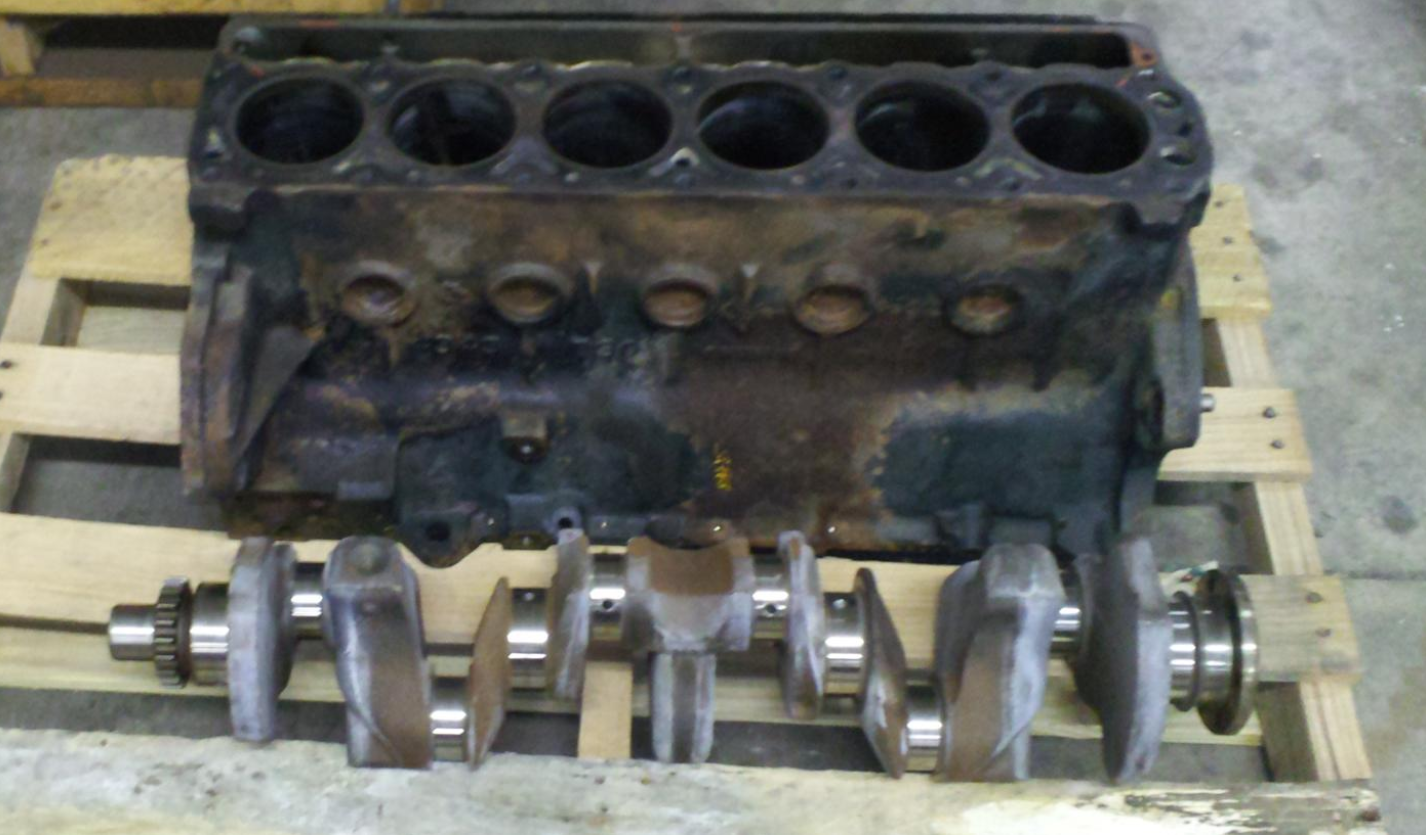
Crankshafts on six-cylinder engines generally have either four or seven main bearings. Larger engines and diesels tend to use seven bearings because of high loadings and to avoid crankshaft flex. Because of the six-cylinder engine's smooth characteristic, there is a tendency for a driver to load the engine at low engine speeds. This can produce crankshaft flex in four main bearing designs where the crank spans the distance of two cylinders between main bearings. This distance is longer than the distance between two adjacent main bearings on a V6 with four mains, because the V6 has cylinder bores on opposite banks which overlap significantly; the overlap may be as high as 100%, minus the width of one connecting rod (1.00" or so). In addition, modern high-compression engines subject the crankshaft to greater bending loads from higher peak gas pressures, requiring the crankthrows to have greater support from adjacent bearings, so it is now customary to design straight-sixes with seven main bearings.[13]
Many of the more sporty high-performance engines use the four bearing design because of better torsional stiffness (e.g., BMW small straight 6, Ford's Zephyr 6). The accumulated length of main bearing journals gives a relatively torsionally flexible crankshaft. The four main bearing design has only six crank throws and four main journals, so is much stiffer in the torsional domain. At high engine speeds, the lack of torsional stiffness can make the seven main bearing design susceptible to torsional flex and potential breakage. Another factor affecting large straight-six engines is the end-mounted timing chain which connects any camshafts to the crankshaft. The camshafts are also quite long and subject to torsional flex as they in turn operate valves alternately near the front of the engine and near the rear. At high engine speeds, camshafts can flex torsionally in addition to the crankshaft, contributing to valve timing for the cylinders furthest from the cam drive becoming inaccurate and erratic, losing power, and in extreme cases resulting in mechanical interference between valve and piston — with catastrophic results. Some designers have experimented with installing the timing chain/gears in the middle of the engine (between cylinders 3 and 4) or adding a second timing chain at the rear of the engine. Either method can solve the problem at the cost of additional complexity.
Another factor reducing the ability of the large six-cylinder engines to achieve high speed is the simple geometric reality of a relatively long stroke (undersquare) design. A straight-six is a long engine, and the designer is usually encouraged to make it as short as possible, while height is not usually a problem. Hence, the tendency to use a longer stroke and smaller bore than in a V engine to achieve a given capacity. By contrast, a long-stroke V engine tends to become too wide, which encourages increasing the bore rather than the stroke to increase displacement.[14] The typically longer stroke of the straight-six increases crank throw and piston speed, and so tends to reduce the rpm rating of the engine.
5. History
The first inline six was produced by Spyker in 1903. By 1909, there were about eighty manufacturers using it, 62 in Britain alone, including Darracq, Delaunay-Bellville, Vertex, MMC, White and Poppe, Mutel, and Ford.[15]
5.1. Continental Europe
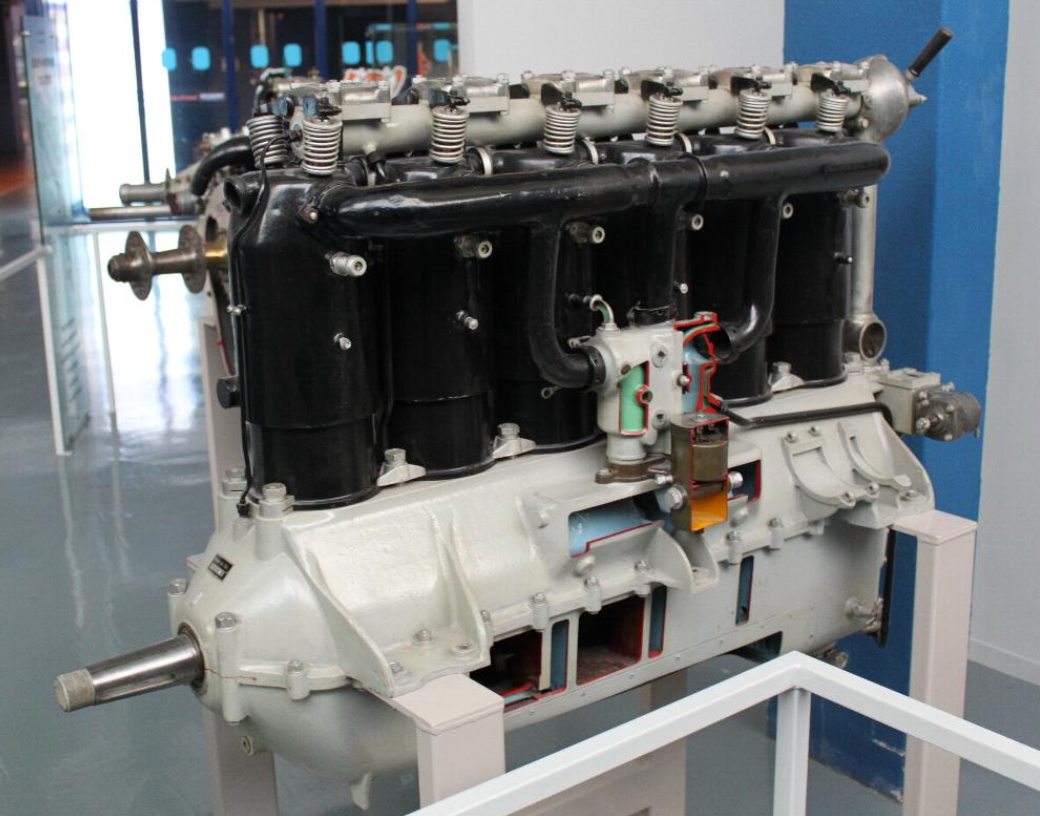
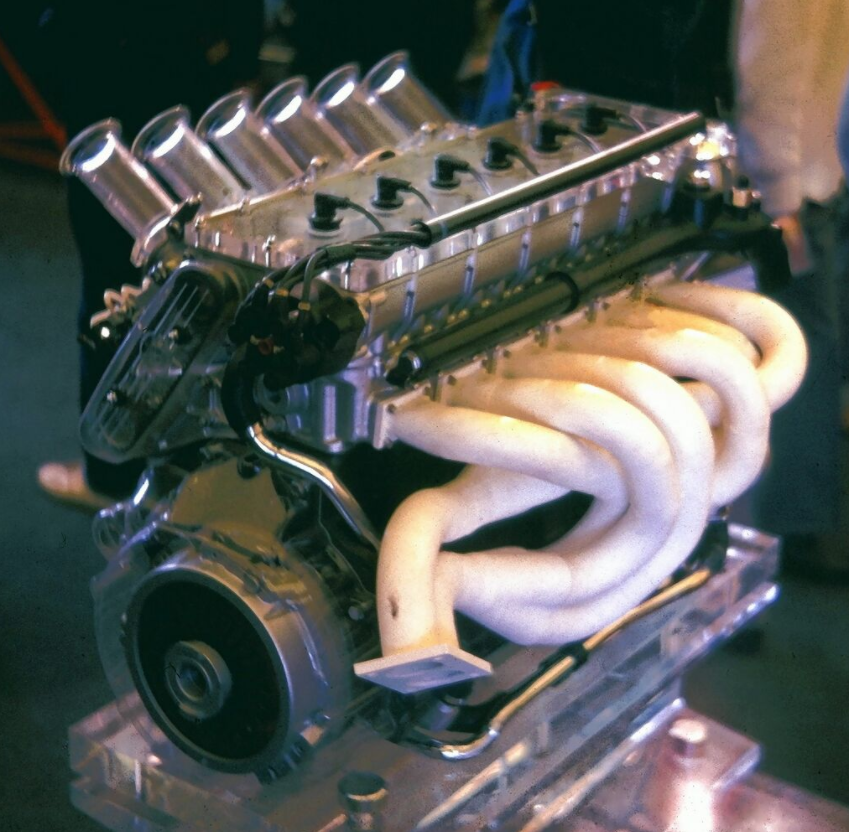
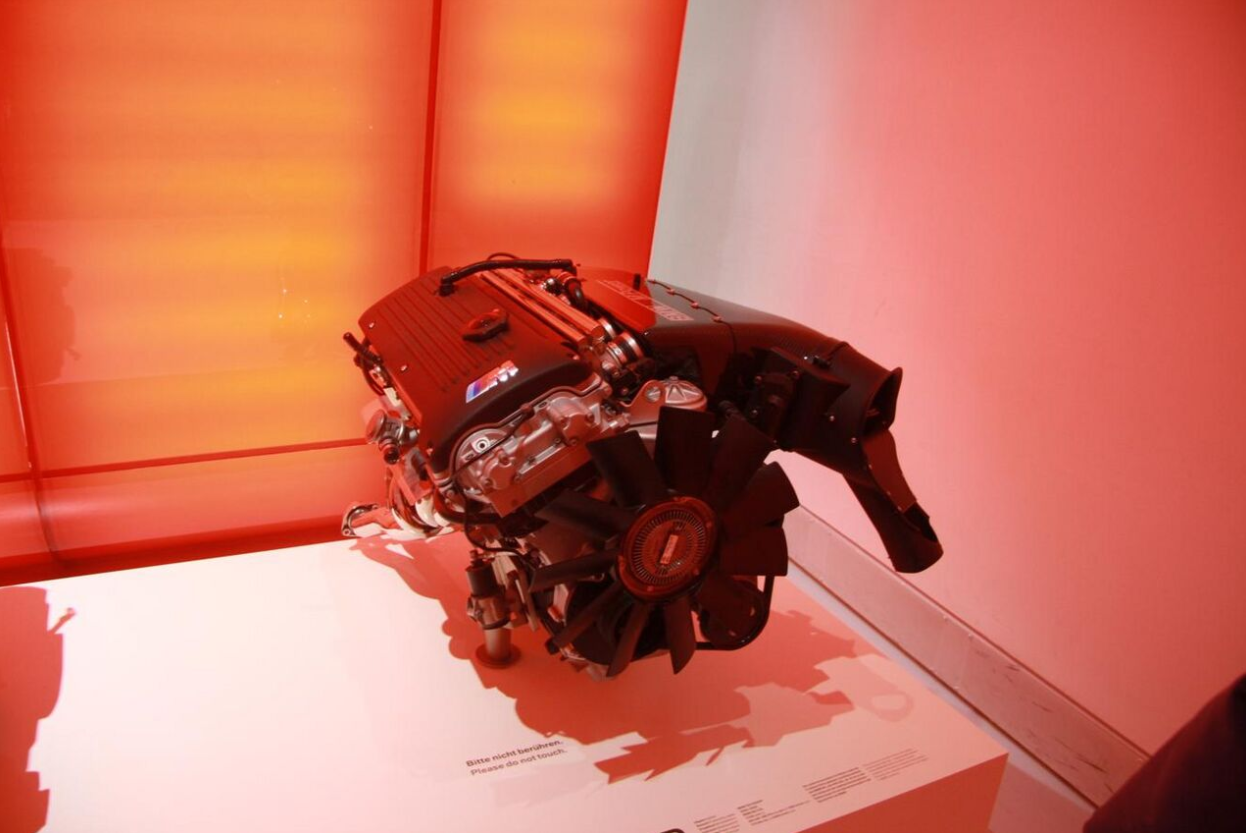
After becoming famous in the last year of World War I through their production of the liquid-cooled BMW IIIa aviation engine of straight-six layout — itself a massive gasoline-fueled engine of some 19 litres (1,164 cu. in.) displacement, BMW introduced its first straight 6-cylinder automotive engine in 1933: the Fritz Fiedler-designed, 30 hp, 50 lb-ft, M78. BMW developed straight-six engines for the post-World War II era by adding two cylinders to its M10 four-cylinder design. In 1968, it introduced a M30 straight-six design with the same 30° slant, overhead camshaft layout, and 100 mm bore spacing as the four. It originally intended to follow up with a V8 engine line in the early 1970s, but when the 1973 oil crisis hit, BMW canceled its V8 plans and concentrated on refining and enlarging its straight-six lineup.[16] These included a smaller straight-six in 2.0 and 2.3 L (120 and 140 cu in) displacements (the BMW M20), versions of the larger BMW M30 up to 3.8 L (230 cu in) (the S38B38); and beginning in 1983, a series of M21 straight-six diesel engines. In 1986, BMW introduced the M70 V12 which was essentially two 2.5 L (150 cu in) straight-sixes on the same crankshaft. In the mid-90s, they produced a series of straight-6s based on the M50 architecture, the ultimate of which was the 330-360 hp S54, used up to 2008. BMW offered a straight-six for their following line up BMW 1 Series, BMW 3 Series, BMW 4 Series, BMW 5 Series, BMW 6 Series, BMW 7 Series, BMW X1, BMW X3, BMW X5, BMW X6, the retired Z3, and current BMW Z4. The BMW B58 3-liter turbocharged inline 6-cylinder, (installed in the M240i) topped Ward's 10 Best Engines of 2017 list. The B58 is rated at 335 horsepower and 369 lb-ft of torque, while achieving 26 mpg.[17]
Mercedes-Benz has used straight-six engines in its cars for around 100 years, starting in the first decade of the 20th century with a monstrous 10 L (610 cu in) engine producing 75 hp (56 kW), and producing in parallel through the World War I years the majority of German aviation engines of straight-six layout, culminating in the Mercedes D.III engine series of 1916–1918 for the Luftstreitkräfte. Before and after the merger of Daimler and Benz in 1926, the combined company produced a variety of powerful straight-six engines, culminating in a 7 L (430 cu in) supercharged unit producing up to 300 hp (224 kW). Mercedes-Benz began the post-war era by producing straight-fours, but resumed making straight-sixes in 1951 with the M130, which was the beginning of the modern era of MB straight-sixes. Following that introduction, the company produced two lines of petrol (gasoline) straight-sixes at any one time, a small six and a larger six, in addition to its straight-fours, straight-fives, and later V8s and V12s. Although the company has used diesel engines in its cars since 1934, it introduced its first straight-six OM603 a 3.0 L (180 cu in) diesel in 1985. In 1996, the company replaced its petrol straight-sixes with a series of 90° M112 V6s, although it continued to produce diesel straight-sixes. In 2017, Mercedes-Benz announced replacing its V6 engines with a new generation of straight-sixes, starting with the petrol M256 and diesel OM656.
Volvo produced straight-sixes, the Volvo B30 engine (1969–1975), also the B6304 and the B6254 engines during the late 1990s. As Volvo developed front-wheel drive models, they mounted their inline-six engine transversely by using a short transaxle package, and relocated engine-driven accessories. The 3.2 L (200 cu in) straight-six introduced in 2006 was only slightly longer than its straight-five, achieved by moving the camshaft drive to the back of the engine and sharing the same gear train with ancillaries mounted in otherwise unused space over top of the transmission. It was short for a straight-six and also very narrow. Volvo claims a transversely mounted inline engine leaves more crush space to protect against frontal impacts than a (shorter) transverse V6 or a longitudinally mounted inline-six.[18]
Opel has also produced a straight-six engine since the 1930s until the early 1990s, ranging between 2.2 and 4.1 L (130 and 250 cu in). They powered Opel's top of the line models, including the Admiral, Kapitän, Rekord, Monza, Senator, Omega A, and Commodore. Until 2003 Omega B was powered also by BMW's straight-six 2.5 L diesel engines.
In 1959, Saab had an experimental car with two transverse straight-three engines bolted together — the Saab Monster.
Alfa Romeo used straight-six engine in G1 and G2 models (1921–1923), RL model (1922–1927) and between 1925 and 1954 in Alfa Romeo 6C series road and racing cars. The 1500 version had one of the smallest straight-six engines (1,487 cc (90.7 cu in)). The last Alfa Romeo model using a straight-six was the Alfa Romeo 2600 (1961–1969). Despite the next Alfa Romeo models being rear-wheel-drive, Alfa switched to a V6 engine, partly due to the experience gained with the six-cylinder in-line engine, which had crankshaft torsional problems that limited the performance potential of the engine. This prompted the study of a unit with cylinders arranged in V developing a more compact and easily installed in an engine compartment without having to resort to long overhang in the front of the car, with the same length, it would be translated as a reduction of passenger car's longitudinal axis.
Maserati has used a straight-six engines widely in old models: A6, 3500 GT, Sebring, etc.
Ferrari has used a straight-six engines in racing models 376 S, 446 S and 735 LM in 1955.
5.2. United Kingdom
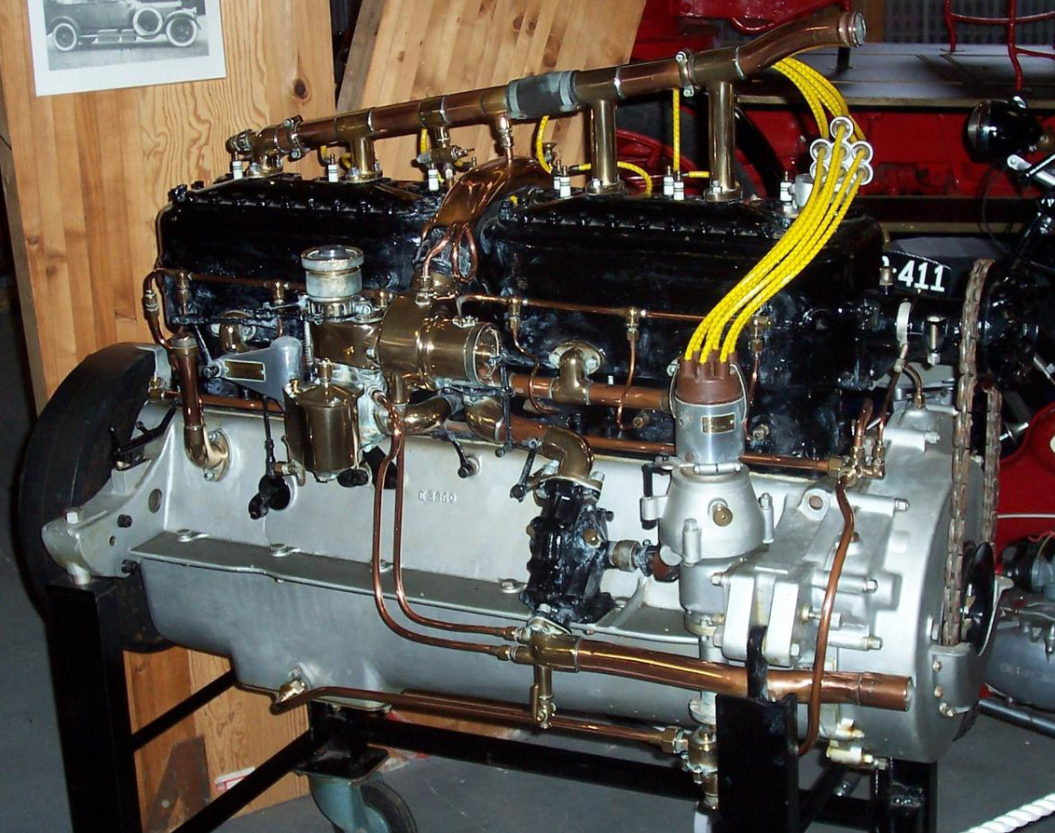
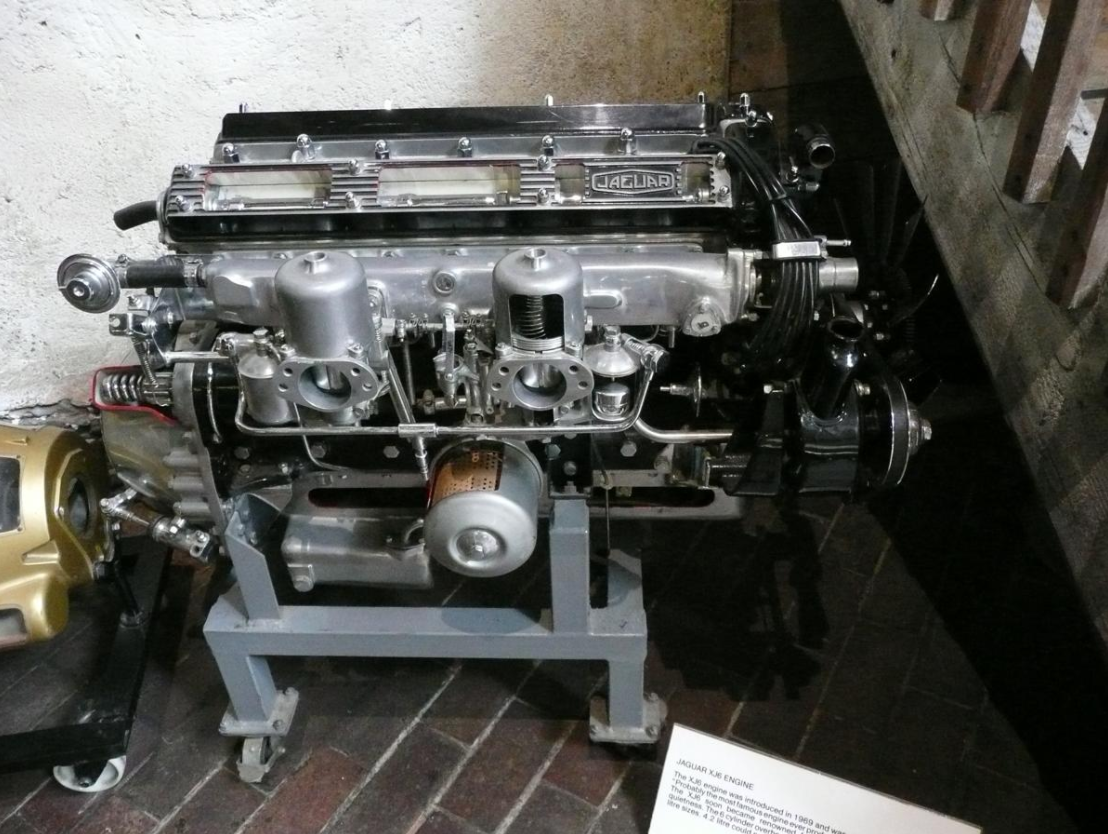
The straight-six was the archetypal United Kingdom engine for sports and luxury cars for many years. Rolls-Royce used straight-six engines until changes in their design made the shorter V8 engine layout more suitable. Jaguar and other manufacturers built straight-six engines from 1935 until the 1990s.
The most prominent of these was the Jaguar XK6 engine, which reportedly was developed over long nights during World War II when Jaguar founder William Lyons and his staff were on fire watch duty in the Jaguar factory in Coventry, and made use of the time to design a new engine.[19] The result was displayed in the Jaguar XK120 at the London Motor Show in 1948. The 3.4 L (210 cu in) twin overhead camshaft XK6 engine was highly advanced compared to previous British engines. The Jaguar XK120 and the XK-powered Jaguar C-Type and Jaguar D-type, went on to score victories in races and rallies in the UK, Europe and North America. They dominated the 24 Hours of Le Mans during the 1950s, where Jaguar C-Types won in 1951 and 1953, and the D-Types had three more wins in 1955, 1956 and 1957. Subsequently, fitted to Lister Cars Lister-Jaguar, the D-type engine contributed to their success in international sportscar-racing in the late-1950s. The engine design, enlarged to 3.8 L (230 cu in), reached its apogee in the Jaguar E-type introduced in 1961, which was capable of 150 mph (240 km/h). In 1964, the XK engine was again enlarged to 4.2 L (260 cu in), which was considered the most powerful and refined of the series. The last XK-engined Jaguar went out of production in 1986, but some XK-engined cars such as the Daimler DS420 limousine were still available into the 1990s.[19] A variant of the 4.2 L engine powered some Scorpion light tanks. The XK6 engine was followed by the AJ6 and AJ16 engines. After Jaguar was acquired by Ford, these engines were replaced with the Ford Duratec-derived Jaguar AJ-V6 engine.
Aston Martin used a straight-six for many years, as did Austin-Healey in their Austin-Healey 3000. The latter used an engine originally built for the Austin Motor Company A105 saloon. Jensen also used Austin straight-six engines in their post-World War II cars until 1962, re-engineering the Austin Sheerline's 4 L DS range to increase the power output. MG also used a straight-six in some pre-war cars (examples: MG K-type and MG N-type) and more recently in the MGC.
Bristol produced a straight-six until 1961, based on a BMW design, that was also used by many small automakers such as AC Cars and Frazer Nash. The Bristol engine had a distinctive valvegear arrangement. The hemispherical combustion chambers meant that the inlet and exhaust valves had to be mounted on separate rocker shafts, giving the engine the appearance of having double overhead camshafts. In fact the engine used a variation on the overhead valve layout, with a camshaft mounted in the engine block driving the inlet rocker arms via traditional vertical pushrods. The inlet rocker shaft had additional cams which drove horizontal pushrods acting on the exhaust rockers on the opposite shaft. The result was an engine with very efficient gas flow due to the placement of the valves and the shape of the combustion chamber but the numerous interfaces between cams, pushrods, rockers and valves required dedicated maintenance to maintain and the engine made a lot of noise when the clearances were allowed to be become excessive.
Prior to World War II, Riley built a number of models fitted with straight-six engines, including the Kestrel 12/6 saloon and the MPH roadster.
The compact Triumph straight-six powered their high-end saloon and sports cars from the mid-1950s to the mid-1970s. It was available in 1.6 L (98 cu in), 2.0 L (120 cu in), and 2.5 L (150 cu in) capacities. Triumph claimed that their TR5 model was the first car in the UK to come with fuel injection as standard; the TR5 has a 2.5 L Triumph straight-six. Other Triumph vehicles that use the Triumph straight-six are:
- GT6 1966–1973
- Vitesse 1962–71
- The 2000 Range 1963–1977
- TR6 1969–1976
The Austin 1800 range was expanded in 1972 when a 2.2 L six-cylinder version of the BMC E-Series engine was installed transversely. The Austin and Morris models were called 2200 and the Wolseley version was called the Wolseley Six. Although this engine was originally designed by BMC in the 1960s it was British Leyland who completed the planned upgrade to the 1800 range when they fitted this motor. This motor then went on to be used in the same configuration on the Princess which superseded the 1800 in 1975. This motor was designed to be as short as possible so the six-cylinder would fit transversely, no water bores were between cylinders and the cylinders were too close together to allow boring; the only way to gain extra capacity was by lengthening the stroke.[20]
The Rover SD1 saloon used straight-sixes of 2.3 and 2.6 L (140 and 160 cu in) capacities, designed by Triumph, as its base and mid-range engines.
British sports car company TVR designed its own straight-six, known as the Speed Six, which was also used in a number of models, including the Cerbera, Tuscan, Tamora, T350C/T, Sagaris and the prototype Typhon. It ranged from 3.6-4.0 litres, with its largest capacity of 4 L (240 cu in) used in the Tuscan and Sagaris. At 405 hp, it is the most powerful naturally aspirated straight-6 ever fitted to a regular production car.
The Rover Company used straight-sixes in many of its saloon cars. A family of straight-4 and straight-6 engines with an unusual 'Inlet-Over-Exhaust' layout were developed. Introduced in the 1930s, these engines were used with great success in Rover's post war cars (the 'P3', 'P4' and 'P5' models). The sixes were available in a variety of capacities- 2.1 L (130 cu in), 2.2 L (130 cu in), 2.3 L (140 cu in), 2.6 L (160 cu in) and 3.0 L (180 cu in). In 1968, Rover began offering the 2.6 L engine as an option in long-wheelbase variants of its Land Rover 4x4. The engine remained available in the Land Rover until 1980, long after production of the other versions of the Rover IOE straight-six had stopped.
Ford UK produced a straight-six engine for the Zephyr and Zodiac range of passenger cars from the Mk1 of 1951 (2262 cc) through the Mk2 (2,553 cc (155.8 cu in)) and Mk3 until 1966. The straight-six was a four main bearing 12 overhead valve design with a short stroke. Rated output grew from just 65 hp (48 kW) in the Mk1 to 110 hp (82 kW) in the Mk3 Zodiac.
5.3. United States
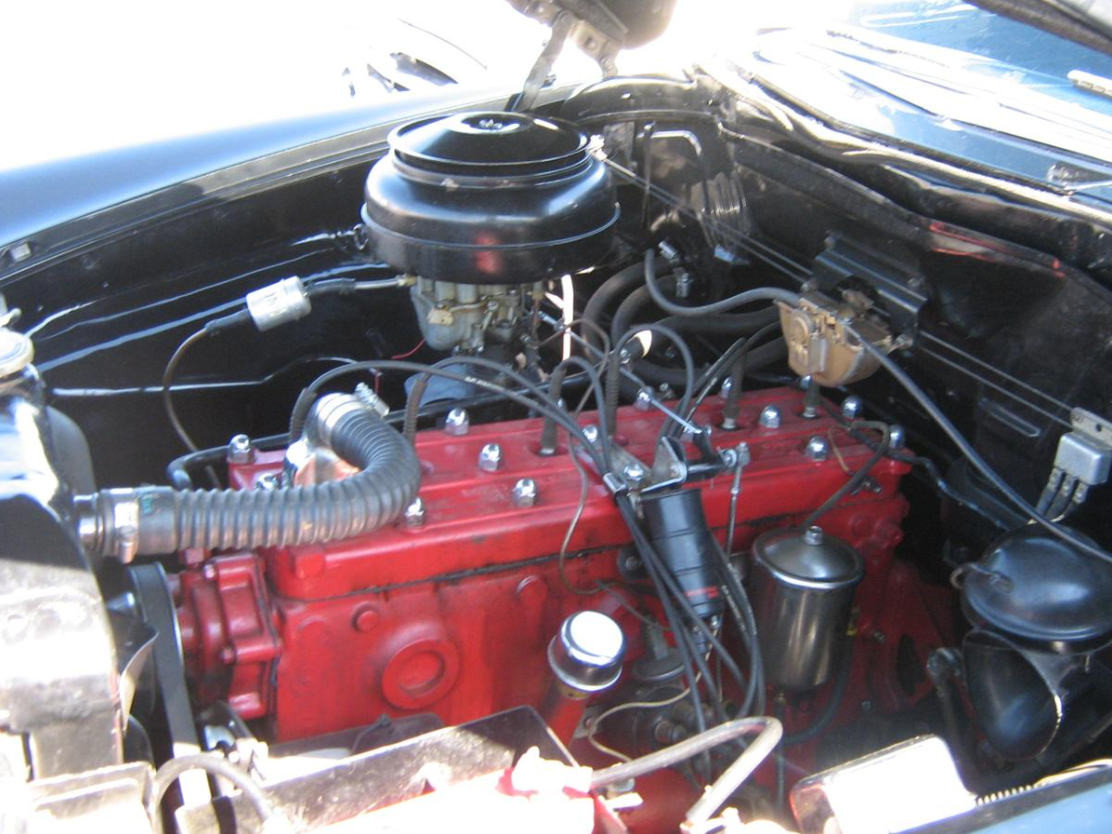
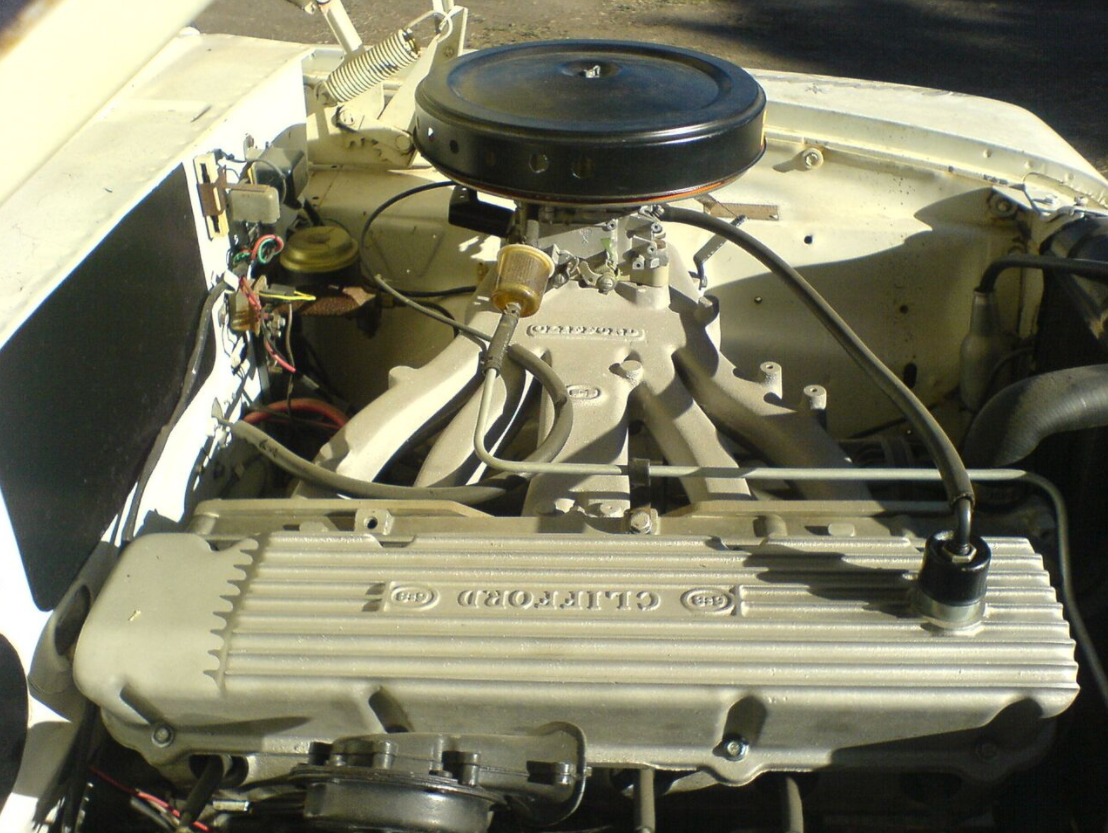
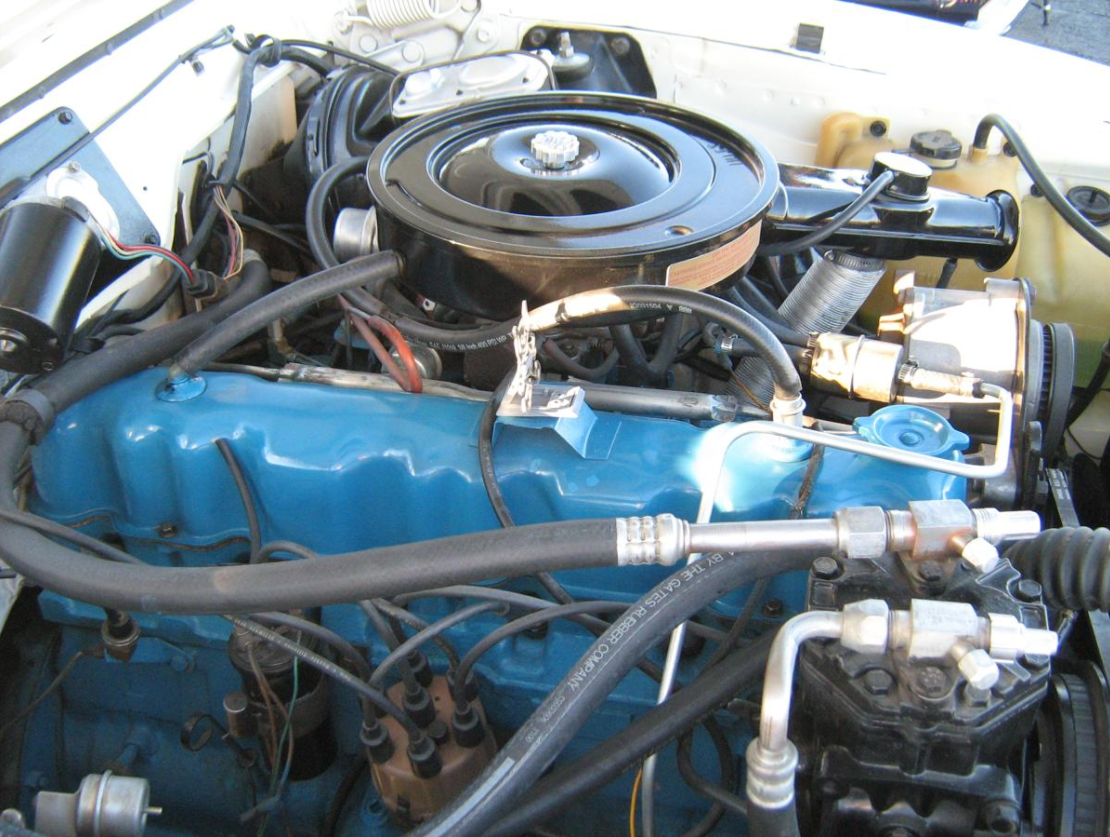
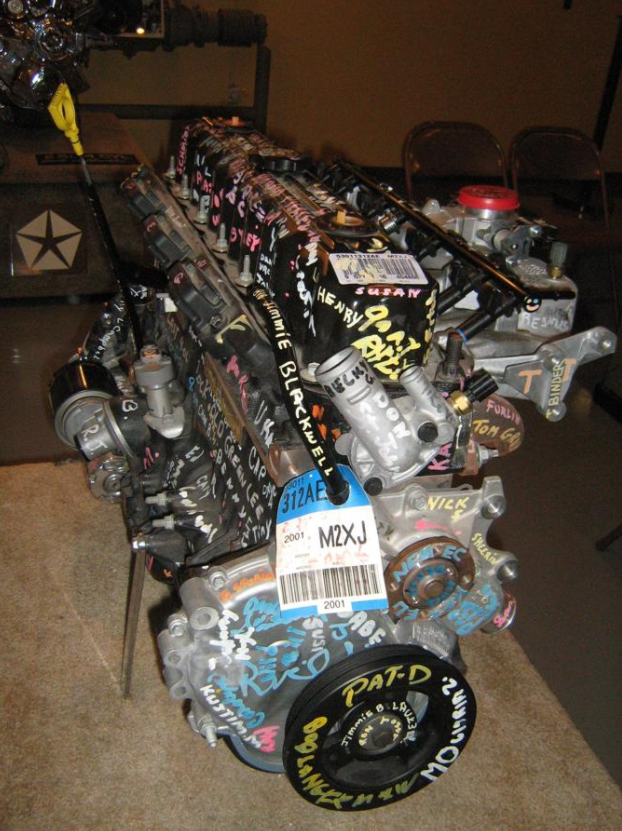
Engines of this type were popular before World War II in mid-range cars. Most manufacturers started building straight-six engines when cars grew too large for the inline-four engine. One of the longest-in-production inline-six automotive engines in the United States was the Chevrolet Straight-6 engine, which replaced Chevy's previous inline-four engine in 1929, and remained in continuous use in the US for powering Chevy vehicles until 1990, in displacements ranging from 3.2 liters (170 cu. in.) to 4.8 liters (292 cu. in.).
After World War II, larger cars required larger engines, and buyers of larger cars tended to prefer V8s; performance sixes such as the Hudson Hornet 308 cu in (5.0 L) engine were exceptions to the rule, and were not often top sellers although it became one of the hottest cars on the road and dominated stock car racing (NASCAR) in the early 1950s.[21]
After Chevrolet introduced its V8 in 1955, the straight-six became almost exclusively a base engine model pitched to economy-minded customers. Trucks (both light and heavy duty) also incorporated the straight-six until the mid-1950s, and they are still used in light trucks available today. The new wave of compact cars that started in the late 1950s provided a suitable home for straight-six designs.
The Chrysler Slant-6 engines used in the Plymouth Valiant and Dodge Dart A-body models of the 1960s and 1970s featured a 30° inclined design to achieve a lower overall height. Originally designed to be built of aluminum, but after encountering problems in manufacturing the engines in aluminum, they were built in cast iron without changing the design to compensate for the stronger metal. Although it only had four crankshaft main bearings instead of the seven used by its competitors, they were the same size as those on the 426 cu in (7.0 L) Hemi V8. The Slant-6 achieved some success in racing when engineers utilized the slant of the engine for very long intake manifold passages to boost horsepower by tuning the intake system. After 30 years of production, it was discontinued in favor of V6 engines because it was too long to mount transversely in front-wheel-drive cars.
Kaiser Jeep introduced the Tornado straight-6 for 1963. It was the first U.S. designed mass-produced overhead cam (OHC) automobile engine. It was robust and built for heavy-duty performance,[22] as well as featuring the lowest specific fuel consumption of all production gasoline engines in the market at the time.[23] However, it was complex (by 1960s standards) for civilian vehicles in the U.S., but continued to be installed in military Jeeps and was also produced through 1982 by IKA in Argentina.
A "modern era" straight-six engine family was introduced by American Motors (AMC) in 1964. These lighter in weight engines were used in a variety of AMC passenger and Jeep utility vehicles. American Motors also sold their straight-sixes to International Harvester for powering International's "Light Line" of trucks: Scouts, pickups, and Travelalls. These engines were also assembled and marketed internationally. Some markets (such as Vehiculos Automotores Mexicanos [VAM] in Mexico) built their own specialized versions. This engine is considered to be one of the best ever made, and it received modifications and upgrades as engine control technology improved.[24] This engine was produced continuously for 42 years (even after Chrysler's buyout of AMC in 1987) all the way through 2006. It featured a durable design with a cast-iron block and cylinder head, hydraulic lifters (with non-adjustable rockers), and seven main bearings.[25] Since AMC cars were designed to take the weight of an optional V8, AMC was able to make their straight-sixes much stronger and heavier than they needed to be. As a result, the engine blocks were so sturdy that some were used in race cars in the Indianapolis 500. In the 1978 race, an AMC 199 cu in (3.3 L) engine built by Navarro produced 875 hp (652 kW; 887 PS) at 8500 rpm with 80 in (2,000 mm) (24.6 lbs) of manifold pressure.[26]
Ford and General Motors straight-sixes of the 1960s and 1970s were generally nondescript, except for the unusual (for the United States) OHC Pontiac six of the late-1960s. Although it was one of the few American straight-sixes of its era to be advertised as exceeding 200 hp (149 kW; 203 PS), it wooed few performance buyers away from V8s during the muscle car era, and was eventually discontinued in favor of a less costly but less powerful pushrod design.
American automakers found it more profitable to sell slow-speed straight-sixes as "economy" engines, and V8s as "performance" engines regardless of their horsepower potential, since big, unsophisticated, overhead valve engines were relatively cheap to manufacture, and fuel economy was not a concern prior to the 1973 oil crisis.
The trend after the fuel crises in the 1970s was towards smaller cars with better fuel economy. Despite this, straight-six engines became rare in American cars, although they continued to be used in trucks and vans. The decline of the straight-six was in response to the more compact size of the V6 layout. The straight-six required a longer engine compartment that was more appropriate to a larger car. The shorter V6 could be used in a shorter engine compartment and therefore fit better in a more compact car. It was also relatively easy to cut two cylinders off a V8 design to produce a V6 e.g. Buick 3800, Chevrolet 90 degree V6 that could be manufactured on the same assembly line as the V8, which was convenient for American manufacturers.
Jeeps were an exception to the trend to V6s, and began offering AMC's 258 cu in (4.2 L), known as "High Torque," straight-sixes as a common engine option in 1972. These engines continued to receive upgrades that were advanced for their time, including the fuel-injected, high-performance 4.0 L (242 cu in) version for the 1987 model-year Cherokee, Wagoneer, and Comanche. In 1988, the engine received higher flowing fuel injectors, raising output to 177 hp (132 kW; 179 PS) and 224 lb⋅ft (304 N⋅m) thus producing more power than some configurations of the Ford 302, Chevrolet 305, and Chrysler 318 V8 engines, and more than any of the Japanese 6-cylinder truck engines, but with comparable or superior fuel efficiency.[27] By 1991, Chrysler was no longer bound by legacy AMC contracts to use engine management systems from Renix and started installing Chrysler computers for the 4.0 L. The 1991 model year also saw the introduction of the 4.0 L in the Jeep Wrangler YJ. In 1993, when the Wagoneer was succeeded by the Grand Cherokee (ZJ), the 4.0 L engine was made the base option. The five millionth 4.0 L was produced in Kenosha, Wisconsin by Chrysler on 15 June 2001, autographed by the assembly workers, and donated to the Rambler Legacy Gallery at the Kenosha History Center. The 4.0 L is regarded as probably one of the best ever Jeep engines and has earned a reputation for its durability.[28][29] Usage of the AMC 4.0 declined in Jeep vehicles after the Jeep Cherokee (in North America) was replaced by the Liberty in 2002, which featured Chrysler's 3.7 L (230 cu in) V6 instead. It declined further after the 2005 introduction of the third generation Jeep Grand Cherokee, which also used the 3.7 L (230 cu in) V6. The last application of AMC's 4.0 straight-six was in the 2006 Jeep Wrangler; for the 2007 model year, the legacy engine was replaced with a 3.8 L (230 cu in) V6.
Ford used a straight-six in baseline Mustangs and in its other models for many decades. They were also found in F-series pickups, E-series vans, and Broncos (most notably the venerable Ford 300 inline six) until 1997 when they were replaced with a V6.
In 1989, Chrysler introduced the 5.9 L (360 cu in) Cummins B Series engine as an option on its Dodge pickup trucks. Displacing nearly 1 L per cylinder, this straight-six turbocharged diesel engine was an attractive alternative to the big gasoline V8s normally used on full-sized pickups, because of its better fuel economy and nearly twice as much low-speed torque.
In 2001, General Motors introduced a new family of straight engines, the Atlas, for use in the Chevrolet TrailBlazer/GMC Envoy. The straight-six was chosen for development because of the desirable operating characteristics of its self-balanced design.[30]
Large gasoline fueled inline sixes were also made for large truck and industrial use by Continental, Hall-Scott, Hercules, Waukesha, Mack, White, Climax, and International Harvester, in sizes ranging up to nearly 1,200 cu in (19.7 L).
In 2018 Chevrolet shown off a 2019 Chevrolet Silverado with a 3.0 liter straight six Duramax diesel engine[31]
5.1. Asia
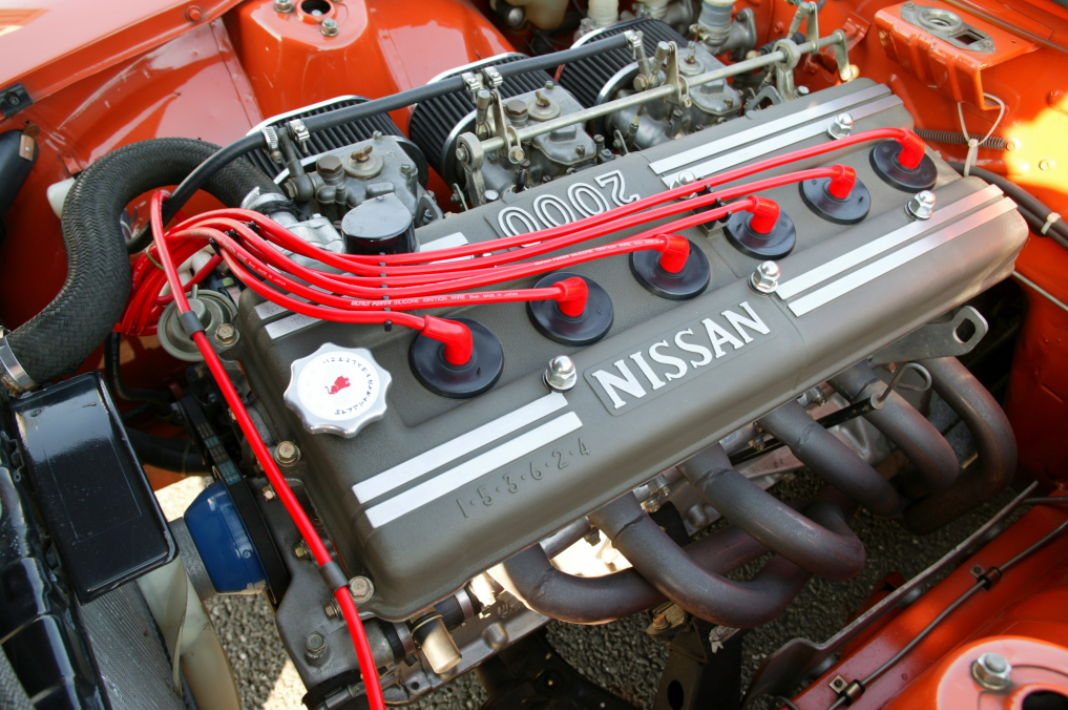
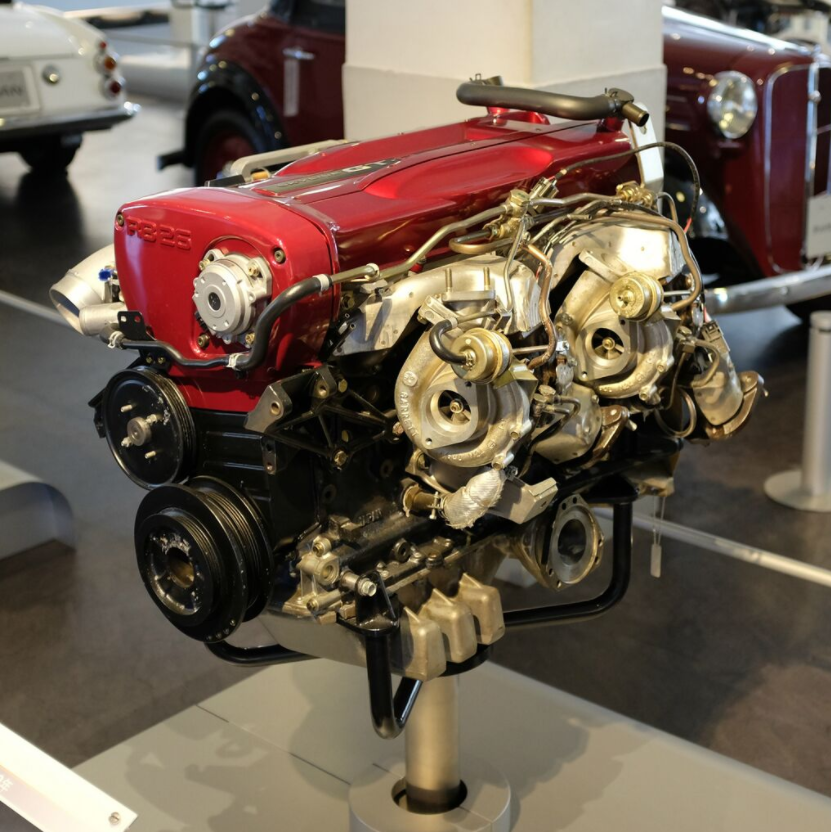
Japanese automakers have used the straight-six since the 1960s in a wide range of vehicles. More recently though, Nissan (the 1984 300ZX switched to V6) and Toyota have changed to V6s, saying the straight-sixes were too expensive to manufacture and too long for the engine compartments in their newer vehicles.
Toyota started with their F-series engine, and later the M, FZ, G, and JZ engines, In the 1990s, Toyota offered straight-sixes in all their lines: the G in the Altezza (and others); the M and its part-replacement, the JZ, in the Toyota Supra (and others); and the F and its replacement, the FZ, in the Land Cruiser. Up until about 2006, Toyota still offered the FZ-series, G-series, and the JZ-series engines.
Nissan started with their H-series, and later the L (up until 1986) of the early Nissan Z-cars, also known as Fairlady Zs, as well as the RB series engines (in the R31-R34 Skyline). They also made the P and TB-series straight six, of which the latter is still currently made and is fitted inside the Patrol Safari.
The first generation of the Mitsubishi Debonair used the KE64 and later the Saturn 6 2.0-liter straight-six engines.
Honda built the Honda CBX motorcycle from 1978 to 1981.[32]
In Korea, GM Daewoo's FWD Magnus (sold abroad as the Chevrolet Evanda, Chevrolet Epica, Holden Epica or Suzuki Verona) comes with a Daewoo-designed straight-six. The Daewoo engine is one of the few straight-sixes designed to be installed transversely in front-wheel drive cars, and it is an extremely short engine in its configuration.
5.5. Australia
All major manufacturers in Australia have used straight configuration for their six-cylinder engines.
BMC developed a straight-six engine based on the B-series engine in the late 1950s. It appeared in the Austin Freeway and Wolseley 24/80. Although successful in Australia, and tried successfully in the prototype MGC, the cost of retooling meant that the engine remained indigenous to Australia. In 1971, Leyland Australia replaced the Austin 1800 with the Austin X6 range, marketed as the Austin Tasman and Austin Kimberley.[33] This car was based on the 1800s platform but had different front and rear styling and a new interior. It introduced a 2.2 L six-cylinder version of the E-series engine four years ahead of the UK market. It has the distinction of being the first car with a transverse front-wheel-drive straight six. The car was supposed to offer more competition to the Australian big six market but it achieved fewer sales than the superseded four-cylinder 1800. The E series six-cylinder in 2.6 L form (achieved using a longer stroke) went on to be used in the Leyland P76 and the Marina.[34]
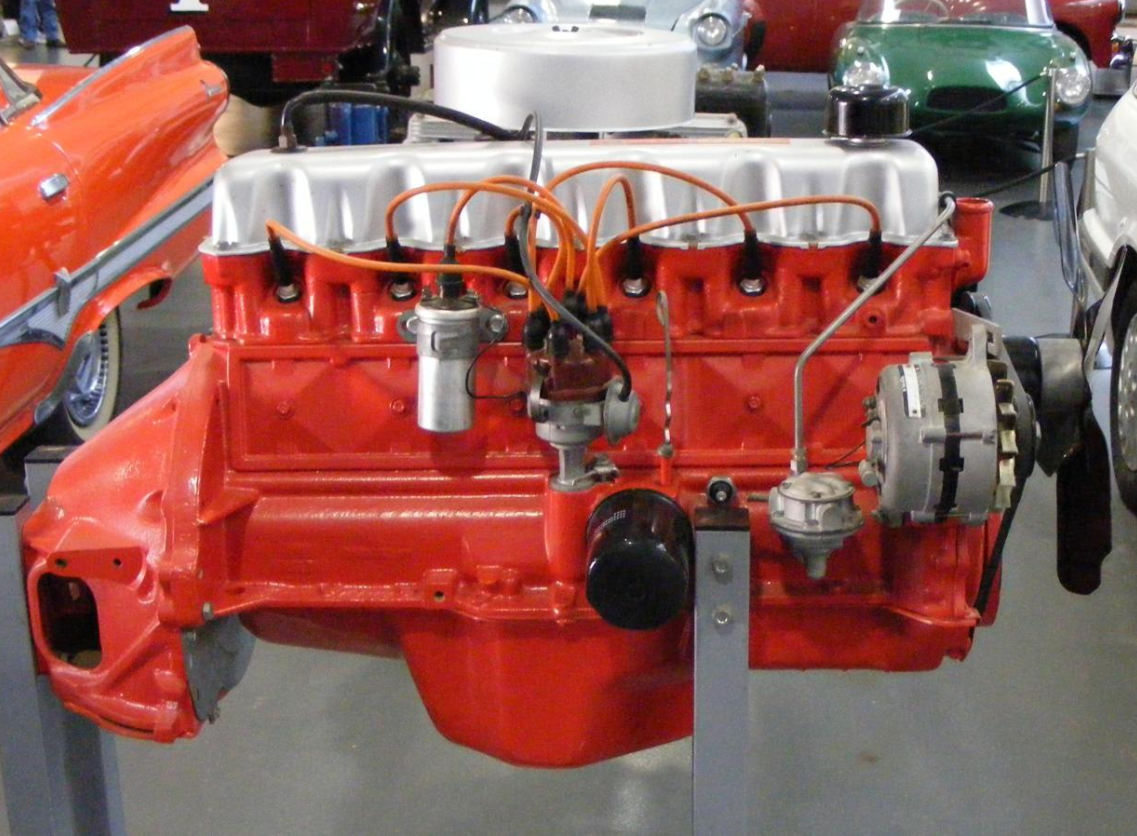
Chrysler manufactured the Slant 6 in Australia. It developed the unique to Australia Chrysler Hemi-6 Engine that was promoted as "the most advanced six-cylinder in the world" when it was launched in 1972.[35] These engines, made in 215 cu in (3.52 L), 245 cu in (4.01 L), and 265 cu in (4.34 L) capacity, were used in the Chrysler Valiant and the Valiant Charger producing up to 320 hp (239 kW). Chrysler no longer owns any factories in Australia.
Holden up until 1986 built their own straight-sixes, adapted from a Chevrolet design. A 132.5 cu in (2.171 L) unit (known as the grey motor) was used until 1963, with a minor increase in displacement in 1960 to 138 cu in (2.26 L) when it was replaced by a newer Chevrolet based design (known as the red engine) which was offered in different capacities. Holden engine sizes included the 138 cu in (2.26 L), 149 cu in (2.44 L), 179 cu in (2.93 L) (1964–1966), 161 cu in (2.64 L), 173 cu in (2.83 L) (1971–1984), 186 cu in (3.05 L) (1968–1971), and 202 cu in (3.31 L) (1971–1986, the largest and most popular of the series). This motor was firstly replaced by an imported RB20/30 Nissan straight-six, offered in 2.0 L (120 cu in) (in New Zealand) and 3.0 L (180 cu in) forms, until Holden's Buick designed 3.8 L (230 cu in) V6 replaced it outright in 1988. Holden now make and use the new global HFV6 in their local and export passenger cars.
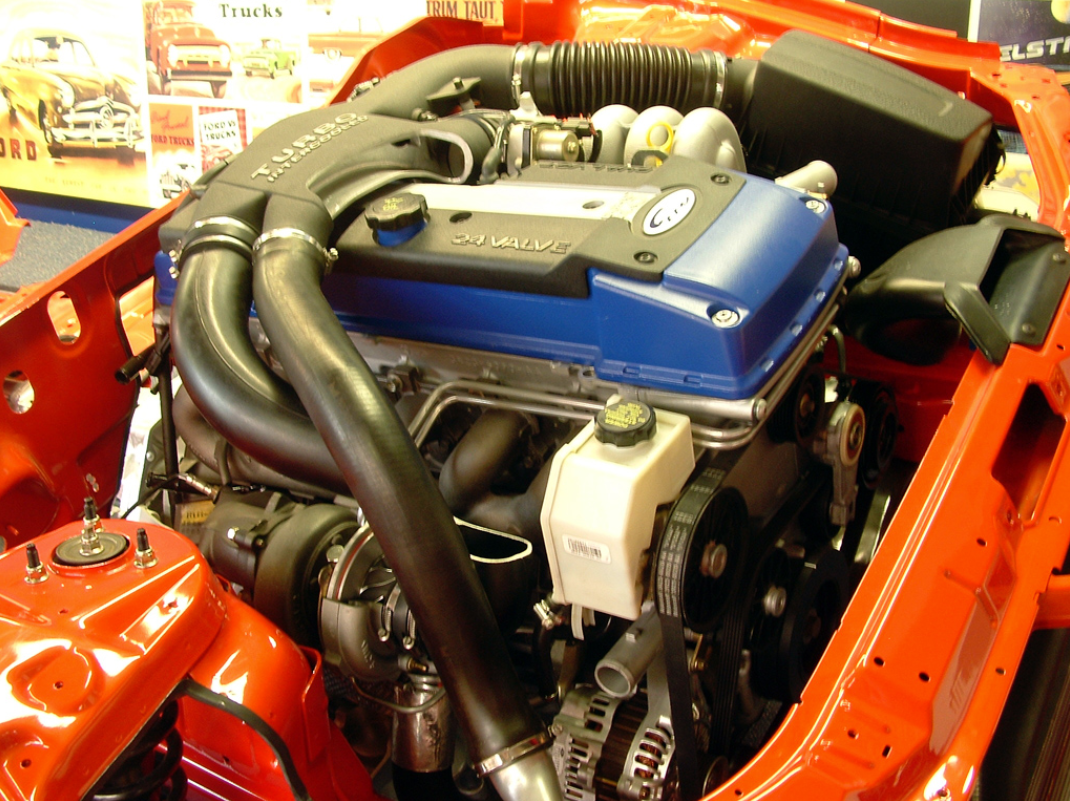
Ford Australia produced straight-sixes between 1960 and 2016, and was the last manufacturer in Australia to build a straight-six. Ford has built 144 cu in (2.36 L), 170 cu in (2.8 L), 188 cu in (3.08 L), 200 cu in (3.3 L), 221 cu in (3.62 L), 240 cu in (3.9 L), and 250 cu in (4.1 L) engines, with the 240 being called the 3.9 L (240 cu in), or 4.0 L (240 cu in) and the 200 being called the 3.3 L (200 cu in). They were used in the Falcon (1960–2016), Cortina (1972–1981) and the Ford Territory (2004–2016). The last straight-six engines in the Falcon and Territory are called the Barra and have a 4.0 L (243 cu in) displacement[36].
The high-performance division of Ford Australia, Ford Performance Vehicles, produced vehicles equipped with the 4.0 L (243 cu in) 24-valve dual overhead camshaft (DOHC) turbocharged straight-six with variable cam timing, which produces 436 hp (325 kW) at 6,000 rpm (100 Hz) and 576 N⋅m (425 lb⋅ft) at 2,750 rpm (45.8 Hz)[36] — the highest level of torque in a six-cylinder powered Australian production car.
6. Motorcycle Use
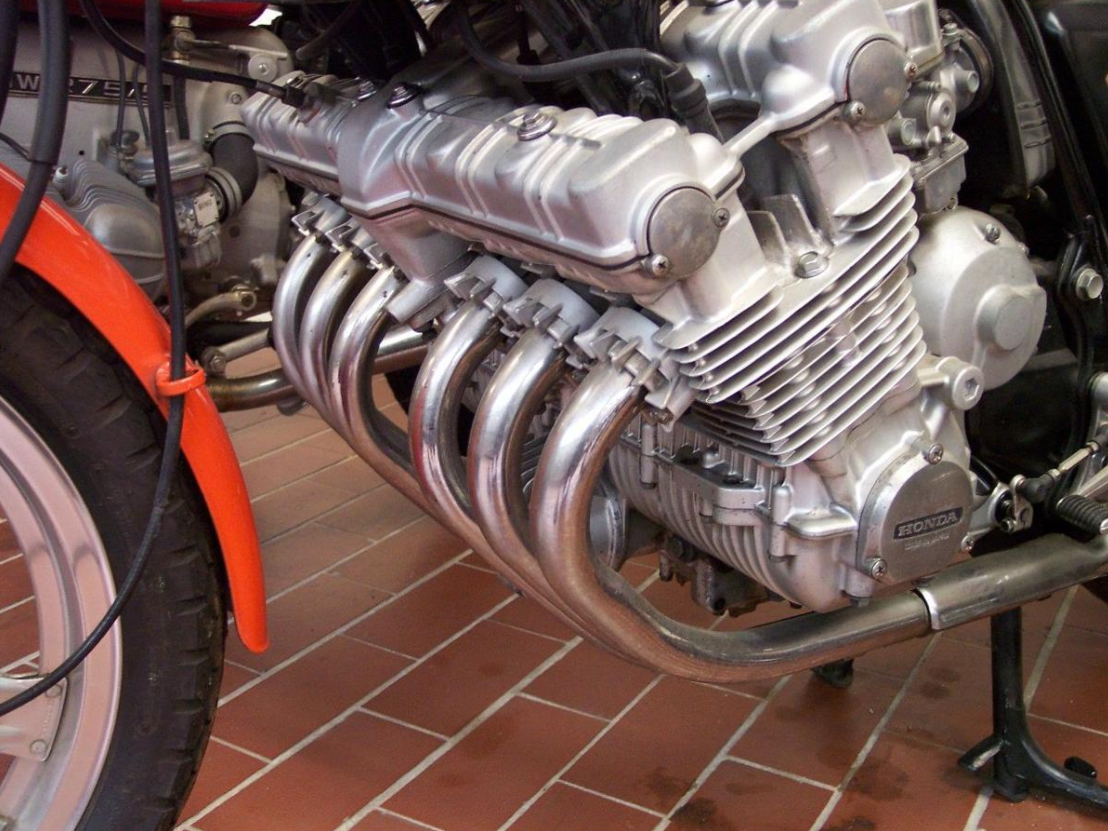
Honda raced a number of straight-six engines in the Honda RC series of motorcycles, starting with the 249 cc (15.2 cu in) 3RC164 in 1964, with a bore of 39 mm, and a stroke of 34.8 mm. This became the RC165 in 1965. For 1966, bore and stroke became 41 mm and 31 mm 246 cc (15.0 cu in) in the RC166, continuing with the RC167 in 1967. Also in 1967, Honda raced the straight-six 297 cc (18.1 cu in) RC174 in the 350 class, with bore and stroke of 41 mm and 37.5 mm.[37]
For road use, Honda introduced the Honda CBX in 1978.[38] Kawasaki introduced the 1,300 cc (79 cu in) KZ1300 in 1979.[39] Benelli introduced the first production motorcycle with a 6-cylinder engine the 750 Sei in 1972, which was later enlarged to 900 cc (55 cu in) to become the 900 Sei.[40]
BMW has developed a straight-six engine for motorcycle use, debuting in a concept bike in 2009,[41] which features on the K1600GT and K1600GTL motorcycles that were launched in 2011.[42] The 1,649 cc (100.6 cu in) engine is mounted transversely across the chassis.[43]
7. Straight-Six Diesel Engines
Straight-six diesel engines with much larger displacements are commonly used for industrial applications. These include various types of heavy equipment, power generation, as well as transit buses or coaches. Virtually every heavy duty over-the-road truck employs an inline-six diesel engine, as well as most medium duty and many light duty diesel trucks. Its virtues are superior low-end torque, very long service life, smooth operation and dependability. On-highway vehicle operators look for straight-six diesels, which are smooth-operating and quiet. Likewise, off-highway applications such as tractors, marine engines, and electric generators need an engine that is rugged and powerful. Unlike passenger cars, compactness is not an important criterion for these applications, while the additional reliability and maintainability of a straight-six diesel engines is.
As with everyday passenger vehicles, the smooth running characteristics of the straight-six engine are what make it desirable for industrial use. The straight-six is a simple engine that is in both primary and secondary balance. This means it can be scaled up to very large sizes without causing excessive vibration. Most of the engine components and accessories can be located along both sides, rather than on top of or underneath the cylinder banks, meaning that access and maintenance is easier than on a V engine in a truck or industrial configuration. In addition, a straight-six engine is mechanically simpler than a V6 or V8 since it has only one cylinder head and the overhead camshaft configuration has half as many camshafts.
7.1. Manufacturers
Diesel straight-sixes are available in passenger cars.
A 2.4l VW diesel was available in the Volvo 240 from 1978.
Mercedes-Benz debuted the OM603 3.0 L (180 cu in) diesel in 1985.
The twin-turbo BMW M57 and N57 engines produce up to 286 PS (210 kW; 282 bhp) and 313 PS (230 kW; 309 bhp) from their 3 L (180 cu in) capacities respectively.
Japanese passenger car diesels include the Nissan RD engine, Nissan LD engine, and the Nissan TD engine, which have similar characteristics to the RB engines.
The 5.9 and 6.7 L straight-six Cummins found in school buses, Dennis Dart buses and Dodge Ram trucks. The DT series medium-duty diesels by Navistar International are also widely used in the North American truck market.
Caterpillar makes straight-six diesel engines for automotive, industrial, and marine applications.
Toyota introduced a straight-six truck diesel engine in 1956, named the 1D, displacing 5.90 L (360 cu in) and its next iteration, the 2D displacing 6.5 L (400 cu in). The H series of straight-six diesel engines were built for nearly 23 years. In 1990, the naturally aspirated engine 1HZ and the turbocharged 1HD-T engine were introduced. The 1HD-T engine was initially used in the Toyota Land Cruiser 80 series and culminated with the EFI equipped, 24 valve, single-camshaft 1HD-FTE, found among others in the Toyota Land Cruiser HDJ100. The 1HZ engine has a single overhead camshaft, 12 valves and produces 131 bhp (98 kW; 133 PS) from its 4.2 L (260 cu in) capacity. The engine was offered for Land Cruisers in the 70, 80, and 100 series, as well as in Coaster buses. In production for more than 23 years with only minor modifications, the 1HZ is still used today in the 70 series and Coaster buses and sold mainly in Australia, Africa, and South America. The Yanmar 6LPA-STP marine engine is based on the Toyota 1HD-FT engine.
Yuchai makes straight-six diesel engines for automotive, industrial, and marine applications.
MAN produces straight-six diesel and natural gas engines for trucks, buses, off-road, marine and industrial applications up to 12.8 litres in capacity.[44]
Scania produces straight-six diesel and natural gas engines for trucks, buses, off-road, marine and industrial applications up to 13 litres in capacity.[45]
References
- Cheetham, p. 209
- Siegal, Margie (October 2006). "The Benelli Sei 750". Motorcycle Classics. http://www.motorcycleclassics.com/classic-italian-motorcycles/benelli-sei-750.aspx?PageId=1#axzz3MI6weXK5. Retrieved 18 December 2014.
- "The 2002–2009 Dodge Ram Heavy Duty". Allpar. 2009. http://www.allpar.com/model/ram/ram-heavy-duty.html. Retrieved 6 August 2009.
- Nunney, p. 4
- Sherman, Don (27 January 2015). "Why 0.5-Liter Cylinders Will Soon Dominate Automotive-Engine Design". Hearst Communications, Inc. http://blog.caranddriver.com/why-0-5-liter-cylinders-will-soon-dominate-automotive-engine-design/.
- Burt, Matt (28 October 2016). "Straight sixes are back! Mercedes-Benz's new 48-volt engine family is here". http://www.carmagazine.co.uk/car-news/tech/the-48-volt-future-of-the-mercedes-benz-four-and-straight-six-cylinder-engine/. Retrieved 11 November 2017.
- "Ram Trucks Towing & Payload Capacity". Ram Trucks. 2016. http://www.ramtrucks.com/en/towing_guide/.
- Nunney, pp. 40–47.
- "Inertial torque – Ash On Bikes". http://www.ashonbikes.com/inertial_torque.
- "Sizing the Flywheel". http://mechanical-design-handbook.blogspot.co.uk/2009/03/sizing-flywheel.html.
- "Crankshaft For Detroit Diesel 6-71 – DP R5 107033 – Diesel Pro Power". http://dieselpro.com/detroit-diesel-crankshafts/671-crankshafts/detroit-diesel-r-5107033-crankshaft-671-standard-rebuilt.html#.Vntg9epsghU.
- "Reed valves Page: 1 – iboats Boating Forums – 394245". http://forums.iboats.com/forum/engine-repair-and-maintenance/mercury-mariner-outboards/394245-reed-valves.
- Nunney, p. 38
- Daniels, p. 100
- G.N. Georgano
- Daniels, p. 163
- Murphy, Tom (12 December 2016). "Seven Turbos, Three Hybrids Share Wards 10 Best Engines Honors 2017 | Wards 10 Best Engines". Penton. http://wardsauto.com/2017/seven-turbos-three-hybrids-share-wards-10-best-engines-honors. Retrieved 24 May 2017.
- New six-cylinder engine from Volvo
- Fifty Years of XK History
- Daniels, J. (1980). British Leyland. Osprey, London. ISBN:0-85045-392-5
- Roberts, Andrew (19 June 2007). "Classic Cars: The Hornet". The Independent. Archived from the original on 31 January 2009. https://web.archive.org/web/20090131095328/http://www.independent.co.uk/extras/cars/classic-cars-the-hornet-453564.html. Retrieved 26 July 2012.
- Page, Ben (2006). "Tornado 230 CI Engine Information / History". International Full Size Jeep Association. http://www.ifsja.org/tech/motors/tornado.html. Retrieved 18 January 2011.
- Foster, Patrick (January 2008). "1963 Jeep Wagoneer - Landmark Vehicle". 4Wheel Drive & Sport Utility Magazine. http://www.4wdandsportutility.com/features/jeep/0801_4wd_1963_jeep_wagoneer/history.html. Retrieved 18 January 2011.
- Zatz, David. "1987, 1988, and 1989 Jeeps: Wrangler, Cherokee, Wagoneer, and Pickup". allpar. http://www.allpar.com/amc/1987-1989-jeep.html. Retrieved 26 July 2012.
- Tellem, Tori (April 2006). "Jeeps Kick Ass Engine – The History Of The 4.0L". JP Magazine. http://www.jpmagazine.com/techarticles/engine/154_0604_jeeps_kick_ass_engine_history_4_liter/index.html. Retrieved 18 January 2011.
- Wilson, Michael. "When the Roar was Red, White & Blue: American Motors and the Indy 500". Archived from the original on 25 October 2009. https://web.archive.org/web/20091025232202/http://geocities.com/mmbb444/page32.html. Retrieved 26 July 2012.
- "The Jeep 4.0 liter PowerTech Straight-Six Engine". Allpar.com. http://www.allpar.com/mopar/40.html. Retrieved 26 July 2012.
- Worthy, Willie (January 2009). "Jeep Motors History – Willies Workbench: Jeep Engines De-Mystified". Four Wheeler. http://www.fourwheeler.com/techarticles/willies/129_0901_jeep_motors_history/index.html. Retrieved 26 July 2012.
- Bartlett, Jeff; Lorentzen, Randy (March 1999). "Road Test: '97 Jeep Cherokee – Long-Term Wrap-Up". Motor Trend. http://www.motortrend.com/roadtests/suv/112_9903_1997_jeep_cherokee/viewall.html. Retrieved 26 July 2012.
- 4200 Overview
- "2019 Chevrolet Silverado Adds 3.0L Duramax Diesel, Ditches 450 lbs - GM Inside News". 13 January 2018. http://www.gminsidenews.com/articles/2019-chevrolet-silverado-adds-3-0l-duramax-diesel-ditches-450-lbs/.
- Greg Williams (November–December 2009). "1981 Honda CBX". Motorcycle Classics. http://www.motorcycleclassics.com/motorcycle-reviews/1981-honda-cbx.aspx. Retrieved 11 November 2009.
- Davis, Tony (1987). Aussie Cars. Marque Publishing. ISBN 9780947079017.
- Robson, Graham (2000). The Cars of BMC (2nd ed.). Motorbooks International. ISBN 9781899870417.
- Wheels staff (26 January 2017). "Australia's top 10 engines". whichcar Australia. https://www.whichcar.com.au/features/australias-top-10-engines. Retrieved 8 October 2019.
- Ford Barra engine
- Honda's Race History
- Honda CBX 1000 Gold Portfolio 1978–1982. R. M. Clarke. Brooklands Books, 24 Jan 1999
- Ultimate History of Fast Bikes Roland Brown. Parragon 2003
- The ultimate motorcycle book. Hugo Wilson. Dorling Kindersley, 15 Sep 1993
- "BMW Will Manufacture Inline Six-Cylinder Tourer: Previewed by the Concept 6". Motorcycledaily.com. Archived from the original on 2 January 2010. https://web.archive.org/web/20100102024219/http://motorcycledaily.com/10november09_bmw_tourer.htm. Retrieved 2010-03-01.
- Newbigging, Chris (2 July 2010). "BMW announces K1600 GT and K1600 GTL six-cylinder tourers". Motorcycle News. http://www.motorcyclenews.com/MCN/News/newsresults/New-bikes/2010/june/jul0210-bmw-announce-k1600-gt-and-gtl/. Retrieved 22 July 2010.
- Madson, Bart (2 July 2010). "2011 BMW K1600GT First Look". Motorcycle USA. http://www.motorcycle-usa.com/616/7370/Motorcycle-Article/2011-BMW-K1600GT-First-Look.aspx. Retrieved 22 July 2010.
- "MAN Engines". http://www.engines.man.eu/global/en/index.html. Retrieved 2016-09-08.
- "Scania Solutions". https://www.scania.com/group/en/section/solutions/. Retrieved 2016-09-08.




